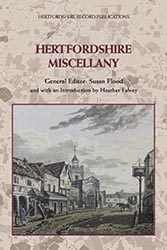
Special Publication:
Hertfordshire Miscellany
In 2025 the Record Society celebrates 40 years of publishing documents relating to Hertfordshire. In recognition of this achievement, we have published Hertfordshire Miscellany, which comprises transcripts of, and commentaries on, several shorter documents, including Athelgifu’s will, c.980-990; inventories of church goods (1590s); a biography of Nathanael Ball (1623-1681), vicar of Barley; the inventory of the goods of William Haskins Stiles at Moor Park mansion (1739); the Tax on Male Servants (1780); and the Fordham family of Hertfordshire, as seen in the Diary and Recollections of Henry Crabb Robinson.
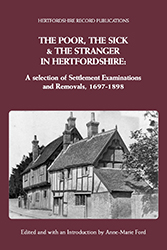
Volume XL:
The Poor, the Sick and the Stranger in Hertfordshire: A Selection of Settlement Examinations and Removals, 1697-1898
Inspired by the Poor Laws and the absence of the poor’s own voices, this book draws on overseers’ records, court documents, and other sources to reconstruct the lives of the impoverished in Hertfordshire, often accused of petty theft and harshly punished. By examining 304 settlement examinations and removals from 1697 to 1898—alongside baptisms, marriages, burials, census data, and newspapers—it gives a fuller picture of individuals otherwise lost to history, offering both a resource for family historians and a deeper understanding of the poor, the sick, and the transient in their social context.
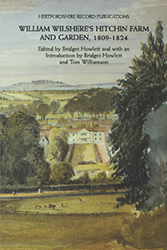
Volume XXXIX:
William Wilshere’s Hitchin Farm and Garden, 1809-1824
William Wilshere (1754-1824) was a Hitchin lawyer. In his later years he farmed about 120 acres of land, mainly to the east of the town of Hitchin, and mainly cultivated for arable crops. He kept several ‘Farm and Gardening Memoranda’, the two books covering the years 1809 to 1824 form this volume. They constitute an unusual and important source for students of both agricultural and garden history: indeed, few surviving journals or notebooks from the eighteenth and nineteenth centuries manage to include an account of both the farming and the horticultural activities of a particular individual. This volume includes plans showing land occupied by Wilshere drawn up in c1808 and 1818 which, together with other evidence, allows the activities described to be placed within a secure spatial frame.
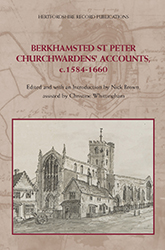
Volume XXXVIII:
Berkhamsted St Peter Churchwardens' Accounts, c.1584-1660
These churchwardens’ accounts from Berkhamsted St Peter in Hertfordshire (1584–1660), extracted from a larger volume held in the British Library, provide detailed records—especially from 1589 to the 1630s—of parish income, burial fees, and church expenses such as roof repairs, bell work, and pulpit improvements reflecting post-Reformation worship. They also show efforts to manage poor relief and parish conduct during times of hardship. Though some years are missing or less detailed, the accounts uniquely span the Civil War and Commonwealth, resuming in full in 1656. Additional material includes inventories of church goods, lists of arms and armour (notably from 1588), and disputes over parish rates for much-needed repairs. An introduction offers context and analysis, shedding light on parish life in early 17th-century England.
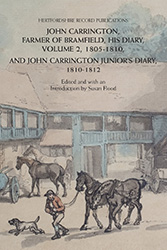
Volume XXXIII:
John Carrington, Farmer Of Bramfield, His Diary, 1798-1810, volume 2, 1805-1810 and John Carrington Junioer's Diary, May 1810-December 1812.
John Carrington, born in 1726, worked as a gardener from a young age before becoming a farmer at Bacons Farm, Bramfield, in 1760. After his wife's death in 1798, he began a near-daily diary that continued until shortly before his death in 1810, offering a vivid account of rural life during the Napoleonic wars. The war-driven rise in produce prices brought him financial stability, enabling property purchases and investments. A respected community figure, he served as Surveyor of the Highways, Overseer of the Poor, and Chief Constable in the Liberty of St Albans. Despite no formal education, he was known for his intelligence, integrity, and generosity. Volume 1 of his diary (1798–1804) was published in 2015; this second volume completes the record through 1810 and includes entries by his son Jack, who continued the diary until 1812. The edition features an introduction, biographies, a glossary, and comprehensive indexes, making the diaries fully accessible.
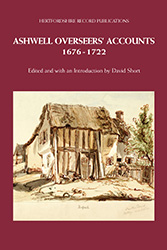
Volume XXXVII:
Ashwell overseers’ accounts, 1676-1722, edited by David Short
The Ashwell overseers’ accounts from 1676 to 1722 offer valuable insight into the operation of the Old Poor Law, which aimed to support the settled poor through pensions (mainly for the elderly), one-off payments, child apprenticeships, and services like nursing, fostering, and burial assistance. Two overseers were elected annually, each serving half a year, reflecting the system’s flexibility and local discretion. Accounts followed a standard format with itemised weekly and casual payments, income details, and vestry approval. Funded by local rates, overseers often had to cover expenses upfront, requiring personal financial means. This edition provides a full transcript of the earliest surviving volume.
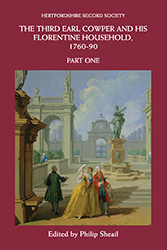
Volume XXXVI:
The Third Earl Cowper and his Florentine Household, 1760–90, edited by Philip Sheail
George Nassau Clavering-Cowper, later the 3rd Earl Cowper, left England in 1757 at age 18 for a Grand Tour of Europe. After falling in love in Florence in 1759, he chose to settle there permanently, remaining in Italy until his death in 1789. His Grand Tour journal, written by his Swiss tutor, is published as Lord Fordwich’s Grand Tour 1756–60 (vol. XXXI). His surviving stewards’ journal accounts (1760–1790) and summary household accounts (from 1779) offer detailed insights into his household’s expenses, growth, and management—especially during a period of financial disarray aided by friend Antonio Menchi. An inventory from his death further reveals the household's nature. Volume XXXVI brings this material together, featuring transcripts from seven sample years of accounts, extracts from summaries, and the full death inventory, along with an introduction outlining the earl’s life and finances.
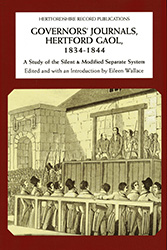
Volume XXXV:
Governors’ Journals, Hertford Gaol, 1834-1844, edited by Eileen Wallace
Volume XXXV presents the Hertford Governors’ Journals from 1834 to 1844, offering a vivid account of life in Hertford gaol following the 1823 Prisons Act, which required governors to record punishments and key events. The journals reveal the harsh conditions endured by inmates—such as floggings, solitary confinement for minor offenses like laughing or singing, and grueling hard labour on the tread wheel or crank. Women and the infirm were made to pick oakum until their fingers bled, all under strict silence and discipline. Despite efforts at moral reform by chaplains, rehabilitation was limited. Public hangings for murder and treason remained popular spectacles, and transportation to Australia continued, with around 520 Hertfordshire prisoners sent away between 1834 and 1844, including children as young as nine.
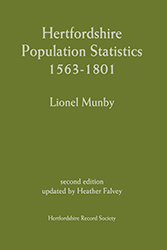
Special Publication:
Hertfordshire Population Statistics 1563-1801 (2nd edition)
Hertfordshire Population Statistics 1563–1801 presents population data for 127 pre-19th century parishes, drawn mainly from ecclesiastical sources that counted parishioners or households, though individual names were not recorded and some returns are incomplete. Introductory chapters explore population trends, the presence of Dissenters and Catholics, and how to interpret the data. First published in 1964 and now reprinted by the Hertfordshire Record Society in tribute to Lionel Munby, the edition includes updated references, added footnotes, a postscript, and two new appendices with recently discovered data from 1595 and surviving hearth tax returns.
Recent volumes from the society
Now Published
- Hertfordshire Miscellany
- Volume XL, The Poor, the Sick and the Stranger in Hertfordshire: A Selection of Settlement Examinations and Removals, 1697-1898
- Volume XXXIX, William Wilshere’s Hitchin Farm and Garden 1809-1824, edited by Bridget Howlett
- Volume XXXVIII, Berkhamsted St Peter Churchwardens' Accounts, c.1584-1660
- VOLUME XXXIII, John Carrington, farmer of Bramfield, his diary, 1798-1810, volume 2, 1805-1810 and John Carrington junior's diary, May 1810-December 1812, edited by Susan Flood
- Volume XXXVII, Ashwell overseers’ accounts, 1676-1722, edited by David Short
- Volume XXXVI, The Third Earl Cowper and his Florentine Household, 1760–90, edited by Philip Sheail
- Volume XXXV, Governors’ Journals, Hertford Gaol, 1834-1844, edited by Eileen Wallace
- Special Publication, Hertfordshire Population Statistics 1563-1801 (2nd edition)